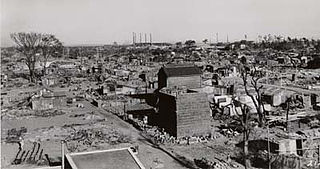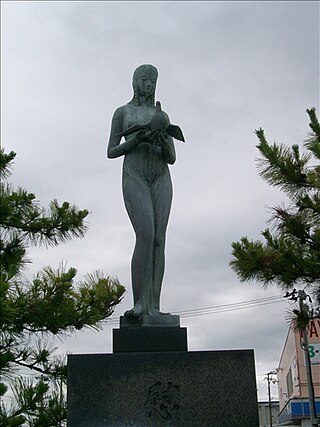
The bombing of Dresden was a joint British and American aerial bombing attack on the city of Dresden, the capital of the German state of Saxony, during World War II. In four raids between 13 and 15 February 1945, 772 heavy bombers of the Royal Air Force (RAF) and 527 of the United States Army Air Forces (USAAF) dropped more than 3,900 tons of high-explosive bombs and incendiary devices on the city. The bombing and the resulting firestorm destroyed more than 1,600 acres (6.5 km2) of the city centre. Up to 25,000 people were killed. Three more USAAF air raids followed, two occurring on 2 March aimed at the city's railway marshalling yard and one smaller raid on 17 April aimed at industrial areas.
The Baedeker Blitz or Baedeker raids was a series of aerial attacks in April and May 1942 by the German Luftwaffe on English cities during the Second World War. The name derives from Baedeker, a series of German tourist guide books, including detailed maps, which were used to select targets for bombing.

Berlin, the capital of Nazi Germany, was subject to 363 air raids during the Second World War. It was bombed by the RAF Bomber Command between 1940 and 1945, the United States Army Air Forces' Eighth Air Force between 1943 and 1945, and the French Air Force in 1940 and between 1944 and 1945 as part of the Allied campaign of strategic bombing of Germany. It was also attacked by aircraft of the Red Air Force in 1941 and particularly in 1945, as Soviet forces closed on the city. British bombers dropped 45,517 tons of bombs, while American aircraft dropped 22,090.3 tons. As the bombings continued, more and more people fled the city. By May 1945, 1.7 million people had fled.

Anthony Clifford Grayling is a British philosopher and author. He was born in Northern Rhodesia and spent most of his childhood there and in Nyasaland. In 2011 he founded and became the first Master of New College of the Humanities, an independent undergraduate college in London. Until June 2011, he was Professor of Philosophy at Birkbeck, University of London, where he taught from 1991. He is also a supernumerary fellow of St Anne's College, Oxford, where he formerly taught.

The Bombing of Hamamatsu in World War II was part of the strategic bombing campaign waged by the United States of America against military and civilian targets and population centers of the Empire of Japan during the Japan home islands campaign in the closing states of World War II.

The Bombing of Numazu in World War II was part of the strategic bombing campaign waged by the United States against military and civilian targets and population centers during the Japan home islands campaign in the closing stages of World War II.

The Bombing of Shizuoka in World War II on June 19, 1945, was part of the strategic bombing campaign waged by the United States against military and civilian targets and population centers during the Japan home islands campaign in the closing stages of World War II.

The Bombing of Hiratsuka in World War II was part of the strategic bombing campaign waged by the United States against military and civilian targets and population centers during the Japan home islands campaign in the closing states of World War II.

The Bombing of Aomori in World War II on July 28, 1945, was part of the strategic bombing campaign waged by the United States against military and civilian targets and population centers during the Japan home islands campaign in the closing stages of World War II.

The Bombing of Tokokawa in World War II was part of the strategic bombing campaign waged by the United States of America against military and civilian targets and population centers during the Japan home islands campaign in the closing stages of World War II.

The Bombing of Kōfu in World War II was part of the strategic bombing campaign waged by the United States against military and civilian targets and population centers of the Empire of Japan during the Japan home islands campaign in the closing states of World War II.
The bombing of Yokkaichi in World War II on June 18, 1945, was part of the strategic bombing campaign waged by the United States against military and civilian targets and population centers during the Japan home islands campaign in the closing stages of World War II.

The Bombing of Akita in World War II, also known as the Tsuchizaki Air Raid, on the night of August 14, 1945, was part of the strategic bombing campaign waged by the United States against military and civilian targets and population centers during the Japan home islands campaign in the closing stages of World War II. This was reportedly the farthest-range and also the last bombing mission in World War II, coming only hours before Japan announced its surrender.

The Bombing of Sendai in World War II on July 10, 1945, was part of the strategic bombing campaign waged by the United States against the civilian population and military targets during the Japan home islands campaign in the closing stages of World War II.

The bombing of Okazaki in World War II was part of the strategic bombing campaign waged by the United States against military and civilian targets and population centers during the Japan home islands campaign in the closing states of World War II.
The Bombing of Kumagaya in World War II on 14 August 1945, was part of the strategic bombing campaign waged by the United States of America against military and civilian targets and population centers during the Japan home islands campaign in the closing stages of World War II.

The bombing of Nagaoka took place on the night of 1 August 1945, as part of the strategic bombing campaign waged by the United States against military and civilian targets and population centers in the Japan home islands during the closing stages of World War II. Between 65.5 and 80 percent of the urban area of Nagaoka was destroyed during the bombing.

On the night of 9/10 March 1945, the United States Army Air Forces (USAAF) conducted a devastating firebombing raid on Tokyo, the Japanese capital city. This attack was code-named Operation Meetinghouse by the USAAF and is known as the Great Tokyo Air Raid in Japan. Bombs dropped from 279 Boeing B-29 Superfortress heavy bombers burned out much of eastern Tokyo. More than 90,000 and possibly over 100,000 Japanese people were killed, mostly civilians, and one million were left homeless, making it the most destructive single air attack in human history. The Japanese air and civil defenses proved largely inadequate; 14 American aircraft and 96 airmen were lost.
The Bombing of Fukui in World War II on July 19, 1945, was part of the strategic bombing campaign waged by the United States against military and civilian targets and population centers during the Japan home islands campaign in the closing stages of World War II.
The Bombing of Gifu in World War II on July 9, 1945 was part of the strategic bombing campaign waged by the United States of America against military and civilian targets and population centers during the Japan home islands campaign in the closing stages of World War II.















